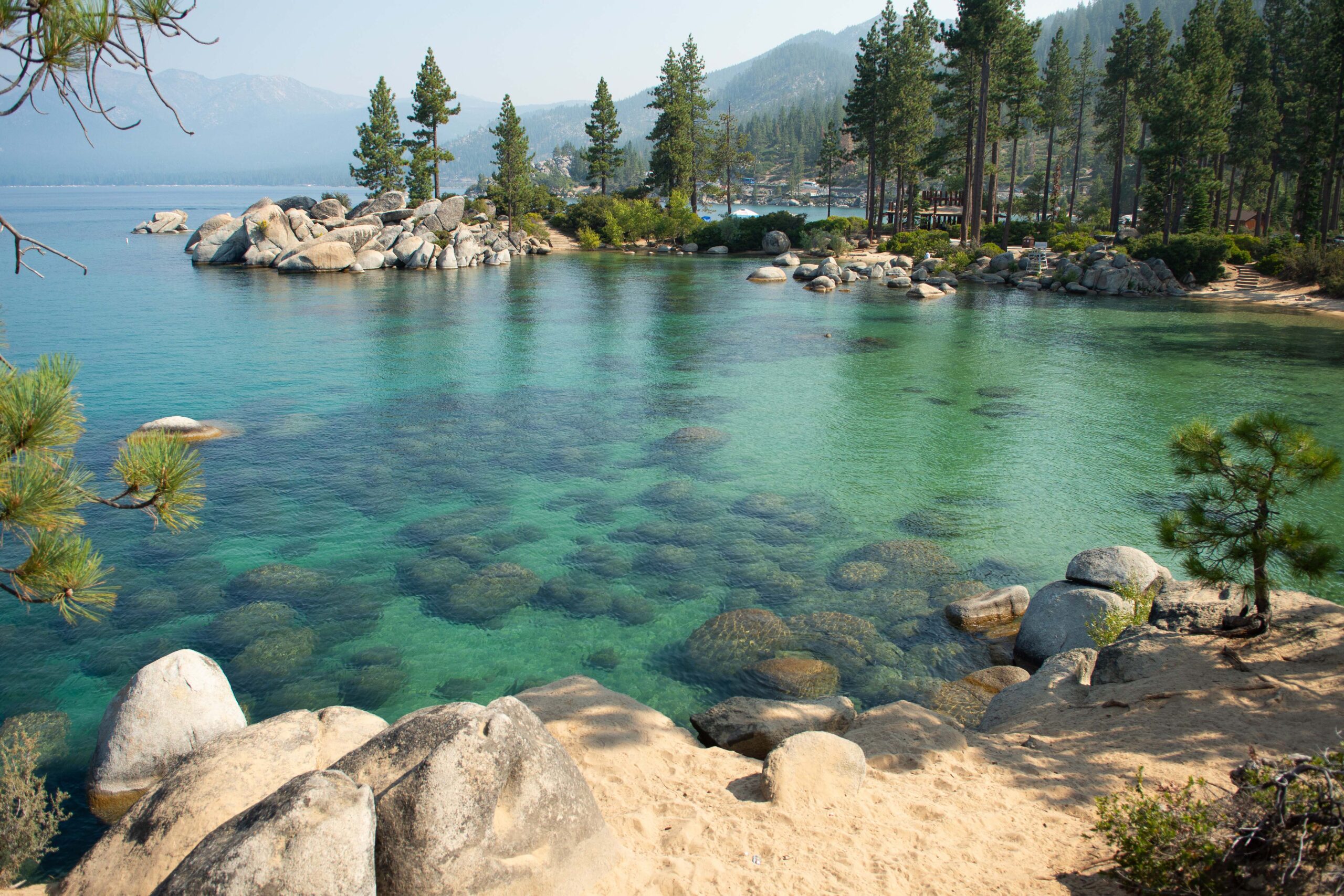What VIPs don’t see: All is not well in Lake Tahoe

From a Lake Tahoe resident’s point of view, it has been surreal to see so many high-profile leaders visit in the span of weeks. To balance rosy reports from agency leads and their development-focused allies (some of whom use nonprofit status to seek more federal, state and local funding), I’d like to provide an insider’s view of life on the ground.
The VIP access afforded to presidents mirrors what we saw in preparation for the recent 27th annual LakeTahoe Summit: illegal buoys vanish from the lake; overflowing trash disappears; and roads clear of construction and tourist gridlock that routinely grind traffic to a stop. If only Tahoe were like that every day.
Residents from rural Tahoe communities heard from a long list of summit speakers including Gov. Joe Lombardo and Speaker Emerita Nancy Pelosi. The theme? Sustainability and stewardship in the face of climate crisis. Apart from a starkly honest assessment from Washoe Tribe leaders, there was a jarring disconnect between what officials had to say about protecting Tahoe and plans in the works.
Local and state leaders are pushing new urban planning development proposals that will increase building density and allow once unthinkable heights to accommodate more people in a basin already straining under the weight of more tourists.
With an already congested two-lane ring road connecting small communities, what happens in the Tahoe Basin generally affects all of us — particularly when it comes to wildfires and extreme weather events. That’s why many of Tahoe’s 55,000 residents oppose plans for an urbanization platform, particularly since it comes with no independent cumulative environmental or coordinated human evacuation plans required.
Tahoe residents haven’t forgotten the poorly executed Caldor fire evacuation. Those affiliated with Sierra Club Tahoe Area Group, North Lake Tahoe Preservation Alliance, Friends of the West Shore, Tahoe East Shore Alliance and Tahoe Neighborhoods Group are rightly alarmed about overdevelopment as climate change dangers increase. Retired fire battalion chief and Tahoe resident Doug Flaherty summed it up: No data-driven Tahoe wide, worst-case fire evacuation plan currently exists.
Lahaina burned during the summit, adding a tragic warning. There are many lessons from Maui for the public and public officials alike. Chief among them is how the lack of worst-case disaster planning scenarios can mean the difference between life and death. For example, officials downplayed and underestimated wildfires’ deadly threat. Visitors further complicated evacuation in Maui’s geographically restricted location.
I deeply empathize with Maui residents who bristle when media diminish their communities with words like “tourist spot” or “vacation destination” in describing what is, in fact, their home. These labels best serve developers, real estate agents and those who materially benefit from tourism revenue. However, they inevitably doom places of natural beauty, relegating them in the minds of the public to mere holiday or Disney-esque getaways.
Tahoe shares similarities with Maui. Both are uniquely beautiful locations with limited infrastructure bound by mountains and a large body of water. There are a mix of full-time occupants and second-home owners. Hotels, motels and inns fill commercial zones and too many short-term rentals afflict residential areas.
Tourists can grossly outnumber residents and population rates vary dramatically. Maui gets 3 million visitors a year; Tahoe gets up to 25 million. Both landed on Fodor’s “No List” for places to visit in 2023 due to the stress and damage of overtourism.
Yet tourists present a new form of existential threat when they compete for precious access to two-lane evacuation routes. As Lahaina demonstrated, sheltering in place during a fast-moving fire proved tragically deadly. Those who survive require shelter, food, medicine and care. Unlike impacted residents, visitors have a safe home to return to.
I recognize that those of us who live in places that only exist on other people’s bucket lists must share nature’s best. In return, visitors must acknowledge they share a responsibility to be respectful and informed, to heed nature’s fury and to not further over-tourism’s destructive forces.
Meanwhile, with life-threatening wildfires and extreme winter weather demanding attention, Tahoe officials continue to make decisions that benefit investors and real estate interests serving the tourism industry. Officials cheer about getting “heads in beds,” yet are loath to admit there is no comprehensive plan for evacuating everyone safely if a wildfire barrels into the basin. Evacuation plans where I live in Tahoe currently do not include nonresidents.
I logged into a San Francisco Bay Area best practices disaster planning webinar and asked how they factor in vacationers. Stumped, the expert admitted they hadn’t considered tourists. Following persistent resident pleas Nevada and California are now "building relationships" toward a unified, cross-jurisdictional command structure but confidence remains low on how disparate agencies with differing software and communication modes will function under duress. Experts who analyzed the Camp Fire in Paradise, California, established the fire grew a football field a second. Other reports examined the risks associated with sheltering in place.
While you might think Tahoe is protected by the bistate Tahoe Regional Planning Agency (TRPA), that is not the case today. It has fallen victim to regulatory capture. TRPA now openly embraces development. It claims to champion affordable housing, yet its latest approvals went to a developer of $2.5 million-plus luxury condominiums and an investor group looking to create a Waldorf Astoria-branded hotel.
With this pro-development backdrop, ski industry executives want to monetize operations year-round. One Olympic Valley proposal acknowledges evacuees would face an 11-hour wait to drive 3 miles to the nearest highway. Year-round expansion, if approved, will bring more people into the greater Tahoe Basin erasing what little shoulder seasons are left.
Officials must acknowledge the hazards that accompany the combination of development-fueled wildfire and overtourism. TRPA and county officials are instead enamored with a new jargon-filled tourism plan. Residents contend it is nothing more than rearranging the deck chairs on the Titanic. It fails to address the gravity of Tahoe’s larger people problem.
July 4 tourists left mountains of garbage, at least 8,500 pounds, on the Lake’s east shore alone, spawning viral coverage worldwide. Day trippers, bikers, hikers with dogs routinely trash beaches and erode trails. Litter also attracts and harms wildlife. The lake is now home to record amounts of microplastics. In short, ever-increasing numbers of people will further destroy the lake environment and complicate evacuations.
Adding insult to injury, the latest Tahoe tourism plan includes proposals to tax residents to pay for visitors. Wouldn’t a better idea be to create an equitable visitor reservation system that establishes a new model for many overwhelmed locations?
Tahoe’s fragile environment and limited local infrastructure is already overburdened. A journalist covering one public meeting later contacted a member of the North Tahoe Public Utility District who told him “there is not enough infrastructure for fire hydrants if too many projects are developed all at once.”
Leaders must now admit the question is not if there’s another massive wildfire, but when. It’s not enough to expect each agency and jurisdiction to have its own plan. Fires don’t respect boundaries.
One of America’s national treasures, Lake Tahoe merits a comprehensive basinwide evacuation plan based on worst-case scenarios and a data-driven roadway wildfire evacuation capacity evaluation that encompasses residents and visitors.
All will benefit from a realistic update of the Tahoe Basin’s carrying capacity. It’s time to amend TRPA code to include specific modern-day thresholds such as evacuation, tourism, human capacity and traffic. It’s only with an updated environmental health assessment that we can determine how much more development and tourism Tahoe can safely accommodate.
Pamela Mahoney Tsigdinos is a writer and Tahoe resident who volunteers with grassroots Tahoe Basin groups
